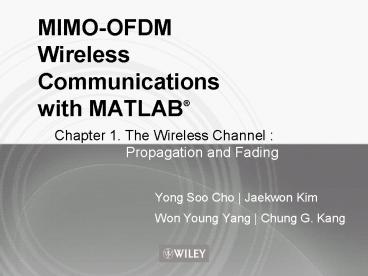MIMO-OFDM Wireless Communications with MATLAB - PowerPoint PPT Presentation
1 / 34
Title:
MIMO-OFDM Wireless Communications with MATLAB
Description:
Wireless Communications with MATLAB Chapter 1. The Wireless Channel : Propagation and Fading Yong Soo Cho | Jaekwon Kim Won Young Yang | Chung G. Kang – PowerPoint PPT presentation
Number of Views:239
Avg rating:3.0/5.0
Title: MIMO-OFDM Wireless Communications with MATLAB
1
MIMO-OFDM WirelessCommunicationswith MATLAB
Chapter 1. The Wireless Channel
Propagation and Fading
- Yong Soo Cho Jaekwon Kim
- Won Young Yang Chung G. Kang
2
Chapter 1. The Wireless Channel
Propagation And Fading
- 1.1 LARGE-SCALE FADING
- - 1.1.1 General Path Loss Model
- - 1.1.2 Okumura/Hata Model
- - 1.1.3 IEEE 802.16d Model
- 1.2 SMALL-SCALE FADING
- - 1.2.1 Parameters for Small-Scale Fading
- - 1.2.2 Time-Dispersive vs. Frequency-Dispersive
Fading - - 1.2.3 Statistical Characterization and
Generation of Fading Channel
3
Chapter 1. The Wireless Channel
- Figure 1.1 Classification of fading channels
4
Chapter 1. The Wireless Channel
Figure 1.2 Large-scale fading vs. small-scale
fading
5
Chapter 1. The Wireless Channel
Figure 1.3 Link budget for the fading
channel(1994 IEEE. Reproduced from Greenwood, D.
and Hanzo, L., Characterization of mobile radio
channels, in Mobile Radio Communications, R.
Steele(ed.), pp. 91185,1994, with permission
from Institute of Electrical and Electronics
Engineers (IEEE).)
6
1.1 Large-scale fading1.1.1 General Path Loss
Model
7
1.1.1 General Path Loss Model
Figure 1.4 Free-space path loss model
8
1.1.1 General Path Loss Model
Environment Path Loss Exponent ( )
Free Space 2
Urban area cellular radio 2.7 to 3.5
Shadowed urban cellular radio 3 to 5
In building Line-Of-Sight 1.6 to 1.8
Obstructed in building 4 to 6
Obstructed in factories 2 to 3
9
1.1.1 General Path Loss Model
Figure 1.5 Log-distance pathloss model
10
1.1.1 General Path Loss Model
Figure 1.6 Log-normal shadowing path loss model
11
1.1.2 Okumura/Hata Model
12
1.1.2 Okumura/Hata Model
13
1.1.2 Okumura/Hata Model
Figure 1.7 Hata path loss model
14
1.1.3 IEEE 802.16d
15
1.1.3 IEEE 802.16d
Parameter Type A Type B Type C
a 4.6 4 3.6
b 0.0075 0.0065 0.005
c 12.6 17.1 20
16
1.1.3 IEEE 802.16d
Parameter Type A Type B Type C
a 4.6 4 3.6
b 0.0075 0.0065 0.005
c 12.6 17.1 20
17
1.1.3 IEEE 802.16d
18
1.1.3 IEEE 802.16d
Figure 1.8 IEEE 802.16d path loss model
Figure 1.9 Modified IEEE 802.16d path loss model
19
1.2 Small-Scale Fading1.2.1 Time-Dispersive vs.
Frequency- Dispersive
Fading
(b) Frequency-selective fading channel
(a) Frequency-non-selective fading channel
Figure 1.10 Characteristics of fading due to time
dispersion over multi-path channel
20
1.2.1 Time-Dispersive vs. Frequency-
Dispersive Fading
Tab Relative delay ( ) Average Power ( )
1 0 0.0
2 110 -9.7
3 190 -19.2
4 410 -22.8
21
1.2.1 Time-Dispersive vs. Frequency-
Dispersive Fading
22
1.2.1 Time-Dispersive vs. Frequency-
Dispersive Fading
23
1.2.1 Time-Dispersive vs. Frequency-
Dispersive Fading
24
1.2.3 Statistical Characterization and
Generation of Fading Channel
Figure 1.11 Planewave arriving at receiver moves
in the direction of x with a velocity of v
25
1.2.3 Statistical Characterization and
Generation of Fading Channel
26
1.2.3 Statistical Characterization and
Generation of Fading Channel
27
1.2.3 Statistical Characterization and
Generation of Fading Channel
28
1.2.3 Statistical Characterization and
Generation of Fading Channel
29
1.2.3 Statistical Characterization and
Generation of Fading Channel
30
1.2.3 Statistical Characterization and
Generation of Fading Channel
31
1.2.3 Statistical Characterization and
Generation of Fading Channel
32
1.2.3 Statistical Characterization and
Generation of Fading Channel
33
1.2.3 Statistical Characterization and
Generation of Fading Channel
34
1.2.3 Statistical Characterization and
Generation of Fading Channel































